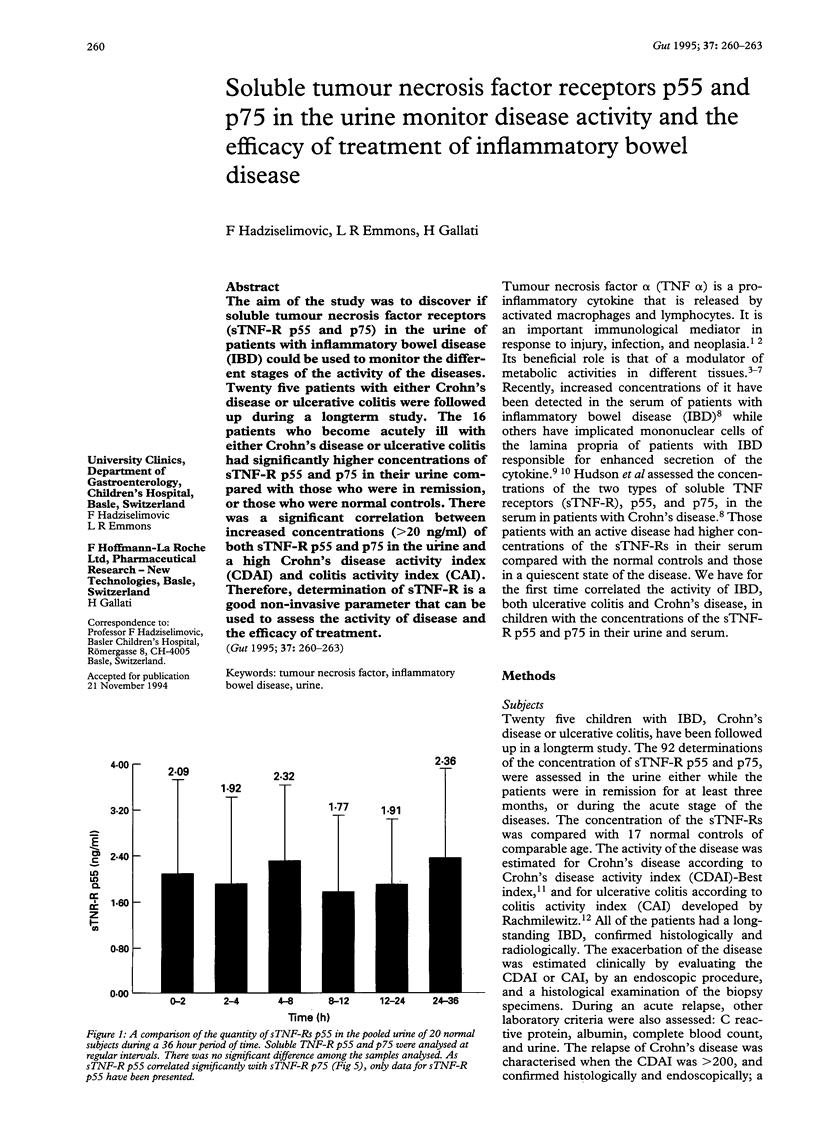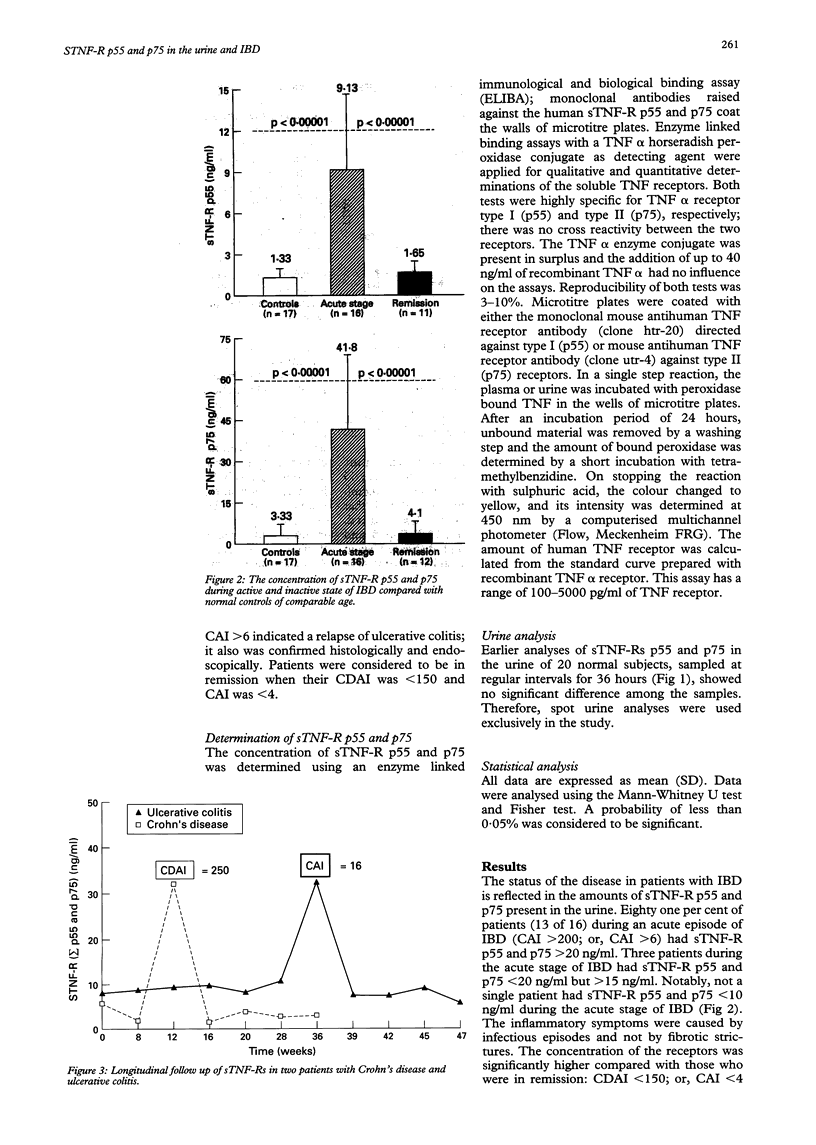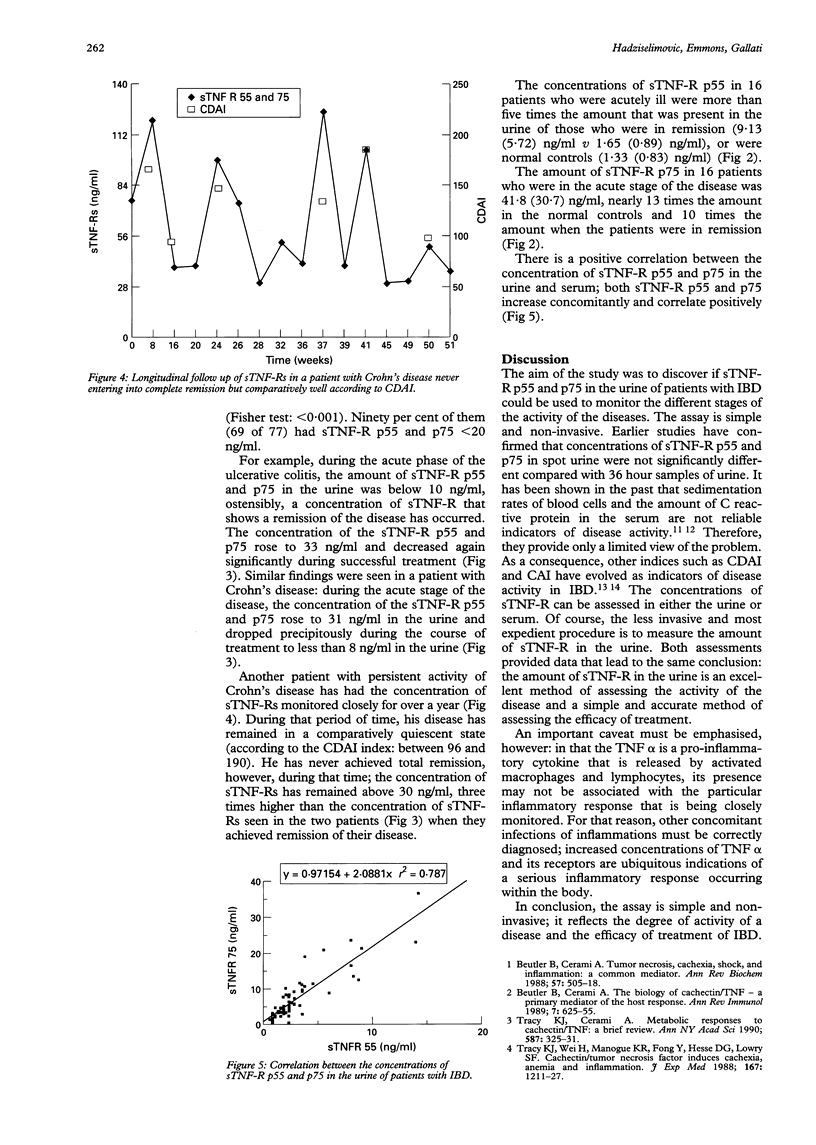Abstract
The aim of the study was to discover if soluble tumour necrosis factor receptors (sTNF-R p55 and p75) in the urine of patients with inflammatory bowel disease (IBD) could be used to monitor the different stages of the activity of the diseases. Twenty five patients with either Crohn's disease or ulcerative colitis were followed up during a longterm study. The 16 patients who become acutely ill with either Crohn's disease or ulcerative colitis had significantly higher concentrations of sTNF-R p55 and p75 in their urine compared with those who were in remission, or those who were normal controls. There was a significant correlation between increased concentrations (> 20 ng/ml) of both sTNF-R p55 and p75 in the urine and a high Crohn's disease activity index (CDAI) and colitis activity index (CAI). Therefore, determination of sTNF-R is a good non-invasive parameter that can be used to assess the activity of disease and the efficacy of treatment.
Full text
PDF



Selected References
These references are in PubMed. This may not be the complete list of references from this article.
- André C., Descos L., André F., Vignal J., Landais P., Fermanian J. Biological measurements of Crohn's disease activity--a reassessment. Hepatogastroenterology. 1985 Jun;32(3):135–137. [PubMed] [Google Scholar]
- Best W. R., Becktel J. M., Singleton J. W., Kern F., Jr Development of a Crohn's disease activity index. National Cooperative Crohn's Disease Study. Gastroenterology. 1976 Mar;70(3):439–444. [PubMed] [Google Scholar]
- Beutler B., Cerami A. The biology of cachectin/TNF--a primary mediator of the host response. Annu Rev Immunol. 1989;7:625–655. doi: 10.1146/annurev.iy.07.040189.003205. [DOI] [PubMed] [Google Scholar]
- Beutler B., Cerami A. Tumor necrosis, cachexia, shock, and inflammation: a common mediator. Annu Rev Biochem. 1988;57:505–518. doi: 10.1146/annurev.bi.57.070188.002445. [DOI] [PubMed] [Google Scholar]
- Fong Y., Moldawer L. L., Marano M., Wei H., Barber A., Manogue K., Tracey K. J., Kuo G., Fischman D. A., Cerami A. Cachectin/TNF or IL-1 alpha induces cachexia with redistribution of body proteins. Am J Physiol. 1989 Mar;256(3 Pt 2):R659–R665. doi: 10.1152/ajpregu.1989.256.3.R659. [DOI] [PubMed] [Google Scholar]
- Johnson R. A., Waddelow T. A., Caro J., Oliff A., Roodman G. D. Chronic exposure to tumor necrosis factor in vivo preferentially inhibits erythropoiesis in nude mice. Blood. 1989 Jul;74(1):130–138. [PubMed] [Google Scholar]
- Maratka Z. Crohn's disease activity indexes: need for distinguishing activity from severity. Hepatogastroenterology. 1981 Aug;28(4):187–188. [PubMed] [Google Scholar]
- Murch S. H., Braegger C. P., Walker-Smith J. A., MacDonald T. T. Location of tumour necrosis factor alpha by immunohistochemistry in chronic inflammatory bowel disease. Gut. 1993 Dec;34(12):1705–1709. doi: 10.1136/gut.34.12.1705. [DOI] [PMC free article] [PubMed] [Google Scholar]
- Reinecker H. C., Steffen M., Witthoeft T., Pflueger I., Schreiber S., MacDermott R. P., Raedler A. Enhanced secretion of tumour necrosis factor-alpha, IL-6, and IL-1 beta by isolated lamina propria mononuclear cells from patients with ulcerative colitis and Crohn's disease. Clin Exp Immunol. 1993 Oct;94(1):174–181. doi: 10.1111/j.1365-2249.1993.tb05997.x. [DOI] [PMC free article] [PubMed] [Google Scholar]
- Tracey K. J., Cerami A. Metabolic responses to cachectin/TNF. A brief review. Ann N Y Acad Sci. 1990;587:325–331. doi: 10.1111/j.1749-6632.1990.tb00173.x. [DOI] [PubMed] [Google Scholar]
- Tracey K. J., Morgello S., Koplin B., Fahey T. J., 3rd, Fox J., Aledo A., Manogue K. R., Cerami A. Metabolic effects of cachectin/tumor necrosis factor are modified by site of production. Cachectin/tumor necrosis factor-secreting tumor in skeletal muscle induces chronic cachexia, while implantation in brain induces predominantly acute anorexia. J Clin Invest. 1990 Dec;86(6):2014–2024. doi: 10.1172/JCI114937. [DOI] [PMC free article] [PubMed] [Google Scholar]


